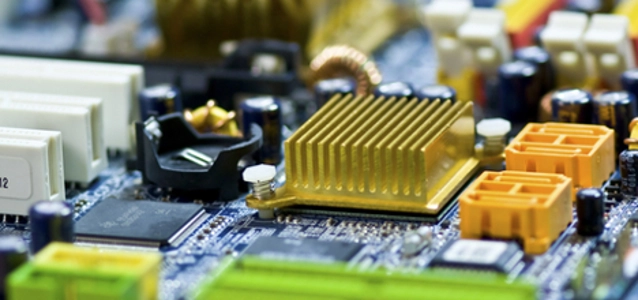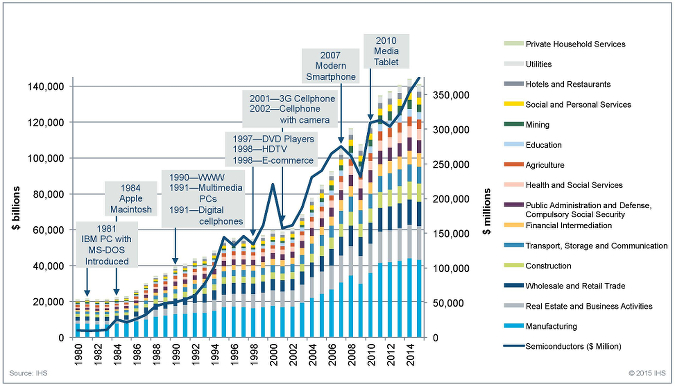
© shanaka wijesooriya dreamstime.com
Analysis |
Moore's Law: 50 years and not a day older
From connectivity to globalization and sustainability, Gordon Moore’s prediction for the pace of semiconductor technology advances has set the stage for global technology innovation and contribution for 50 years.
The exponential advances predicted by Moore’s Law have transformed the world we live in. The ongoing innovation, invention and investment in technology and the effects that arise from it are likely to enable continued advances along this same path in the future, according to a new report from IHS Inc. (NYSE: IHS), the leading global source of critical information and insight. Titled “Celebrating the 50th Anniversary of Moore’s Law,” the report describes how the activity predicted by Moore’s Law not only drives technological change, but has also created huge economic value and driven social advancement.
In April of 1965, Fairchild Semiconductor’s Research and Development Director, Gordon Moore, who later founded Intel, penned an article that led with the observation that transistors would decrease in cost and increase in performance at an exponential rate. Moore specifically, posited that the quantity of transistors that can be incorporated into a single chip would approximately double every 18 to 24 months. This seminal observation was later dubbed “Moore’s Law.”
“Fifty years ago today, Moore defined the trajectory of the semiconductor industry, with profound consequences that continue to touch every aspect of our day-to-day lives,” said Dale Ford, vice president and chief analyst for IHS Technology. “In fact, Moore’s Law forecast a period of explosive growth in innovation that has transformed life as we know it.”
The IHS Technology report, which is available as a free download, finds that an estimated $3 trillion of additional value has been added to the global gross domestic product (GDP), plus another $9 trillion of indirect value in the last 20 years, due to the pace of innovation predicted by Moore’s Law. The total value is more than the combined GDP of France, Germany, Italy and the United Kingdom.
If the cadence of Moore’s Law had slowed to every three years, rather than two years, technology would have only advanced to 1998 levels: smart phones would be nine years away, the commercial Internet in its infancy (five years old) and social media would not yet have skyrocketed.
“Moore’s Law has proven to be the most effective predictive tool of the last half-century of technological innovation, economic advancement, and by association, social and cultural change,” Ford said. “It has implications for connectivity and the way we interact, as evidenced by the way social relationships now span the globe. It also provides insight into globalization and economic growth, as technology continues to transform entire industries and economies. Finally it reveals the importance of how sustainability affects life on Earth, as we continue to transform our physical world in both positive and negative ways.”
The Moore’s Law Era: Explosive Economic and Societal Change
The consequences of Moore’s Law has fueled multifactor productivity growth. The activity forecast by the law has contributed a full percentage point to real GDP growth, including both direct and indirect impact, every year between 1995 and 2011, representing 37 percent of global economic impact..
“Not even Gordon Moore himself predicted the blistering pace of change for the modern world,” Ford said. “While it is true most people have never seen a microprocessor, every day we benefit from experiences that are all made possible by the exponential growth in technologies that underpin modern life.”
According to the “Moore’s Law Impact Report,” the repercussions of Moore’s Law have contributed to an improved quality of life, because of the advances made possible in healthcare, sustainability and other industries. The results of advanced digital technology include the following:
 © IHS
Moore’s observation has transformed computing from a rare, expensive capability into an affordable, pervasive and powerful force – the foundation for Internet, social media, modern data analytics and more. “Moore’s Law has helped inspire invention, giving the world more powerful computers and devices that enable us to connect to each other, to be creative, to be productive, to learn and stay informed, to manage health and finances, and to be entertained,” Ford said.
Millennials: The Stewards of Moore’s Law
From the changing shape and feel of how humans communicate to the delivery of healthcare, changing modes of transportation, cities of the future, harvesting energy resources, classroom learning and more – technology innovations that spring from Moore’s Law likely will remain a foundational force for growth into the next decade.
From data sharing, self-driving cars and drones to smart cities, smart homes and smart agriculture, Moore’s Law will enable people to continuously shrink technology and make it more power efficient, allowing creators, engineers and makers to rethink where – and in what situations – computing is possible and desirable.
Computing may disappear into the objects and spaces that we interact with – even the fabric of our clothes or ingestible tracking devices in our bodies. New devices may be created with powerful, inexpensive technology and combining this with the ability to pool and share more information, new experiences become possible.
© IHS
Moore’s observation has transformed computing from a rare, expensive capability into an affordable, pervasive and powerful force – the foundation for Internet, social media, modern data analytics and more. “Moore’s Law has helped inspire invention, giving the world more powerful computers and devices that enable us to connect to each other, to be creative, to be productive, to learn and stay informed, to manage health and finances, and to be entertained,” Ford said.
Millennials: The Stewards of Moore’s Law
From the changing shape and feel of how humans communicate to the delivery of healthcare, changing modes of transportation, cities of the future, harvesting energy resources, classroom learning and more – technology innovations that spring from Moore’s Law likely will remain a foundational force for growth into the next decade.
From data sharing, self-driving cars and drones to smart cities, smart homes and smart agriculture, Moore’s Law will enable people to continuously shrink technology and make it more power efficient, allowing creators, engineers and makers to rethink where – and in what situations – computing is possible and desirable.
Computing may disappear into the objects and spaces that we interact with – even the fabric of our clothes or ingestible tracking devices in our bodies. New devices may be created with powerful, inexpensive technology and combining this with the ability to pool and share more information, new experiences become possible.
- Forty percent of the world’s households now have high-speed connections, compared to less than 0.1 percent in 1991
- Up to 150 billion incremental barrels of oil could potentially be extracted from discovered global oil fields
- Researchers can perform 1.5 million high-speed screening tests per week (up from 180 in 1997), allowing for the development of new material, such as bio-fuels and feedstock’s for plant-based chemicals
 © IHS
Moore’s observation has transformed computing from a rare, expensive capability into an affordable, pervasive and powerful force – the foundation for Internet, social media, modern data analytics and more. “Moore’s Law has helped inspire invention, giving the world more powerful computers and devices that enable us to connect to each other, to be creative, to be productive, to learn and stay informed, to manage health and finances, and to be entertained,” Ford said.
Millennials: The Stewards of Moore’s Law
From the changing shape and feel of how humans communicate to the delivery of healthcare, changing modes of transportation, cities of the future, harvesting energy resources, classroom learning and more – technology innovations that spring from Moore’s Law likely will remain a foundational force for growth into the next decade.
From data sharing, self-driving cars and drones to smart cities, smart homes and smart agriculture, Moore’s Law will enable people to continuously shrink technology and make it more power efficient, allowing creators, engineers and makers to rethink where – and in what situations – computing is possible and desirable.
Computing may disappear into the objects and spaces that we interact with – even the fabric of our clothes or ingestible tracking devices in our bodies. New devices may be created with powerful, inexpensive technology and combining this with the ability to pool and share more information, new experiences become possible.
© IHS
Moore’s observation has transformed computing from a rare, expensive capability into an affordable, pervasive and powerful force – the foundation for Internet, social media, modern data analytics and more. “Moore’s Law has helped inspire invention, giving the world more powerful computers and devices that enable us to connect to each other, to be creative, to be productive, to learn and stay informed, to manage health and finances, and to be entertained,” Ford said.
Millennials: The Stewards of Moore’s Law
From the changing shape and feel of how humans communicate to the delivery of healthcare, changing modes of transportation, cities of the future, harvesting energy resources, classroom learning and more – technology innovations that spring from Moore’s Law likely will remain a foundational force for growth into the next decade.
From data sharing, self-driving cars and drones to smart cities, smart homes and smart agriculture, Moore’s Law will enable people to continuously shrink technology and make it more power efficient, allowing creators, engineers and makers to rethink where – and in what situations – computing is possible and desirable.
Computing may disappear into the objects and spaces that we interact with – even the fabric of our clothes or ingestible tracking devices in our bodies. New devices may be created with powerful, inexpensive technology and combining this with the ability to pool and share more information, new experiences become possible.
